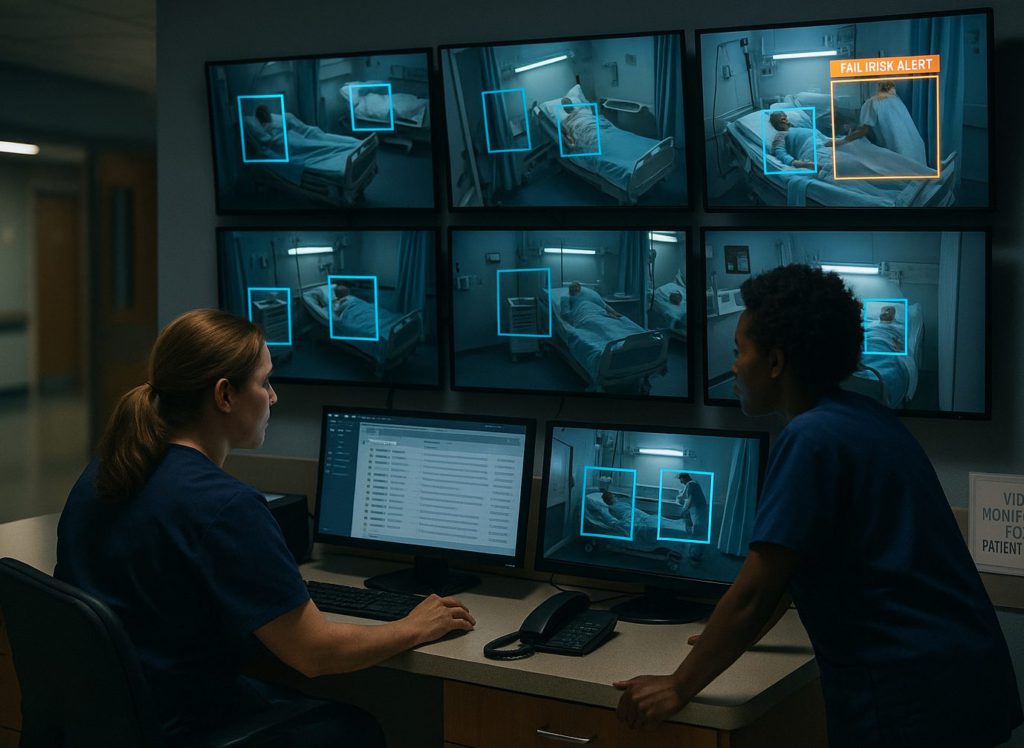Curious how the facial recognition and video‑analytics ideas in this article translate into practice? Explore them in a safe sandbox and pressure‑test governance approaches with DeepXHub. Create a free account.
I. Executive Summary
Imagine a healthcare system that’s smarter, safer, and more seamless. That is the promise of Facial Recognition Technology (FRT). This powerful application of AI and computer vision is rapidly transforming the industry. This is not just a futuristic concept; it’s a reality now. Indeed, a soaring global healthcare biometrics market drives its growth, and experts project it will grow at an impressive 18% CAGR from 2023 to 2032. In this report, we pull back the curtain on five game-changing computer vision applications. These applications are set to redefine how we experience healthcare – from the moment we walk in the door to the minute we leave. We’ll explore how this technology solves deep-seated problems. These include medical misidentification, fraud, and diagnostic delays, all of which carry significant human and financial costs.
Of course, with great power comes great responsibility. The journey to a smarter healthcare system is filled with complex ethical and legal challenges. For this reason, this report also dives into the most critical issues. These include data privacy, the insidious problem of algorithmic bias, and the fundamental need for true informed consent. Unlike a password, your face is permanent. Consequently, if this data is compromised, the consequences can be catastrophic. Furthermore, a documented history of algorithm inaccuracies for certain demographic groups raises serious concerns. Automated discrimination and the potential for life-threatening misdiagnoses are real risks. In this analysis, we offer a path forward. Our strategic recommendations for stakeholders will help them ensure they deploy this powerful technology with integrity and equity.
II. Introduction: The Evolving Landscape of Digital Health
Today’s healthcare world faces high stakes. We are in a constant battle to protect our most personal information – our protected health information (PHI). For instance, in 2023 alone, we saw a staggering two data breaches a day. An average of 364,571 medical records were compromised daily. But the real cost is not just financial. While medical fraud drains up to $68 billion from the U.S. system each year, patient misidentification has an even more grim human toll.
Misidentification, for instance, links to a chilling 13% of surgical errors. It contributes to an annual industry cost of $17.4 billion in medical mistakes. These are not just statistics; they are stories of misdiagnoses, delayed treatments, and dangerous billing errors. They highlight an urgent need for a more secure way to verify who we are. Consequently, facial recognition technology steps in.
Say goodbye to flimsy ID cards, forgotten PIN codes, and the hassle of manual data entry. FRT is an artificial intelligence tool. It uses our unique, non-transferable biological traits to create a secure, contactless, and real-time method of patient verification. The technology’s ability to quickly and accurately confirm identity is more than a convenience. It’s a strategic shield against the financial and clinical risks that have plagued the healthcare system for decades. In the following sections, we will explore the five most impactful facial recognition solutions in healthcare. We will also take an honest look at the ethical, legal, and social challenges we must face to ensure this technology serves everyone safely and responsibly.
III. Core Applications of Facial Recognition in Healthcare
1. The Welcome Mat: Streamlining Patient Check-in and Identification with AI Face Scanning
Think about your last doctor’s appointment. Did you stand in a long line, fumbling for your insurance card and a pen to fill out a clipboard? This outdated process is a prime example of an operational bottleneck that facial recognition technology can shatter. These facial recognition solutions create a secure, frictionless patient experience. They free us from paper and plastic ID cards. When you arrive, a terminal with a face detection camera can perform an ai face scanning in less than a second. It uses an intricate face recognition model to instantly match your face to your pre-registered profile. The system confirms your identity. It requires no staff intervention for you to be automatically checked in.
This seamless automation isn’t just about speed; it’s about safety. It eliminates human identification errors and slashes wait times. It also prevents queues from snaking out the door. But its most profound impact is in risk mitigation. Patient misidentification is a pervasive and costly problem, linked to everything from treatment delays and billing discrepancies to a huge portion of the $68 billion annual medical fraud bill in the U.S. This computer vision application is far more than a convenience; it’s a strategic defense against these systemic failures. Case in point: in June 2021, the Geisinger hospital network in Pennsylvania implemented FRT as a positive patient identification tool. The system links a patient’s image facial recognition scan directly to their electronic health record (EHR). As of the article’s publication, over 4,000 patients had already been logged – proving this is not just a theory, but a real-world revolution in progress.
2. The Digital Guardian: Enhancing Security with Facial Recognition Solutions
In a hospital, every doorway and every computer holds a secret – critical data that must be protected. A face recognition security system provides a robust, contactless method for access control. It stands guard over sensitive areas like operating rooms, pharmacies, and patient record archives. People can easily lose or steal ID badges. In contrast, your unique facial features cannot be shared. This ensures that only authorized personnel can enter these restricted zones. It also minimizes the risk of data breaches and theft.
Beyond physical security, these facial recognition solutions offer a powerful way to protect digital assets. Imagine a password-free login to electronic health records and other vital systems. This form of biometric authentication is a double-win. It enhances data integrity and privacy, ensuring compliance with strict regulations like HIPAA and GDPR. It also tackles the all-too-common problem of “password fatigue” among overworked healthcare professionals. Some solutions can even perform a “liveness check.” This ensures the person in front of the terminal is a real human, not just a photo or a mask. This extra layer of security allows medical staff instant, fumbling-free access to critical areas. This is invaluable, especially when every second counts in an emergency.
3. The Clinical Compass: Advancing Diagnosis with AI-Powered Image Recognition
For families facing a rare genetic disorder, the journey to a diagnosis can be a long and agonizing “diagnostic odyssey.” This is where one of the most powerful computer vision applications in healthcare comes to the rescue. Many of these rare conditions present with subtle facial features, or dysmorphologies, that a clinician might easily miss if they haven’t encountered that specific syndrome before.
AI, powered by deep learning algorithms, acts as a powerful new lens. It analyzes and quantifies facial features to help clinicians highlight potential diagnoses.
4. The Virtual Handshake: Improving Telemedicine Security with Facial Recognition
The rise of telemedicine has made healthcare more accessible than ever. However, it also introduced a new question: how do we truly know who is on the other end of the screen? Facial recognition technology is the answer. It plays a crucial role in securely verifying a patient’s identity before and during a virtual visit. This capability is the digital handshake that ensures the person accessing their medical records is the patient they claim to be.
This application provides multiple layers of protection. First, it’s a powerful tool for fraud prevention. It reduces the risk of medical identity theft. It also blocks unauthorized insurance claims and fraud. Second, it strengthens data privacy. In a virtual care setting, FRT ensures that only the correct patient can access their protected health information. This helps organizations maintain compliance with strict regulations like HIPAA. The technology provides a secure, contactless method of authentication. It is the foundation for building a trusted and reliable telehealth ecosystem.
5. The Silent Guardian: Proactive Patient Monitoring with AI-Powered Video Analytics
What if a hospital could predict a fall before it happens? Using AI-powered video analytics, healthcare facilities are creating a “silent guardian” for their most vulnerable patients. This video analytics solution is a fundamental shift from a reactive to a proactive care model. Instead of waiting for a fall, these video intelligence systems detect subtle changes in a patient’s posture or movements. These changes may signal instability. When a potential fall is detected, the system triggers an immediate alert. This allows staff to intervene and prevent serious injuries.
Beyond fall prevention, this video analysis ai is also a lifeline for overworked nursing staff. It provides automated, round-the-clock monitoring. Real-time cctv monitoring using video analytics frees up nurses from continuous manual observation. It allows them to focus on other critical tasks and helps minimize the costs associated with patient sitters. Some systems even include two-way audio. Staff can communicate with patients remotely, instructing them to stay in bed and await assistance. This proactively prevents a fall. Furthermore, researchers are exploring this technology for its ability to analyze facial expression recognition. It can identify signs of pain, depression, or anxiety. Ultimately, this could provide clinicians with valuable insights for more accurate evaluations and better-informed care.

IV. Critical Challenges and Ethical Imperatives
The potential benefits of facial recognition technology in healthcare are immense. However, its implementation is not without significant challenges and ethical considerations. We must address them meticulously. The unique nature of biometric data, combined with documented algorithmic limitations, necessitates a careful and transparent approach to deployment.
1. The Inescapable Threat of Data Privacy and Security for Facial Recognition
The collection and storage of facial biometric data present a profound privacy challenge. Unlike a password, which you can change, your facial data is permanent and uniquely identifiable. If compromised, it can lead to a catastrophic event. A significant concern is the lack of transparency about how organizations collect, store, and use this data. FRT systems can operate without a user’s informed consent. They capture images in real-time, which enables silent surveillance.
A serious risk exists for “function creep.” Data collected for one purpose – like patient check-in – can be repurposed or shared for other uses without your knowledge or consent. While some vendors claim they de-identify data to protect privacy, some experts are skeptical that biometric data can be truly anonymized. The data is often “multi-omic,” connecting different types of information. This increases the possibility of re-identification. Healthcare organizations must adhere to strict regulations like HIPAA and GDPR. These grant special protection to biometric data and PHI. The legal landscape is still catching up. A lack of clear, national laws to protect against violations from FRT use by law enforcement, for example, highlights regulatory gaps. The reliance on local servers for data storage without skilled IT security professionals also presents a major vulnerability to breaches.
2. Algorithmic Blind Spots: Bias and Automated Discrimination in Facial Recognition
A critical ethical issue with facial recognition is algorithmic bias. Studies by the National Institute of Standards and Technology (NIST) have repeatedly confirmed that leading algorithms have different accuracy rates for different demographic groups. For instance, a 2018 study found that gender classification algorithms had an error rate of just 1% for white men. In contrast, it was a staggering 34.7% for darker-skinned women. Further NIST testing in 2019 confirmed that most algorithms have higher false positive rates for Asians, African Americans, and American Indians compared to white individuals. The rates were also higher for women compared to men.
The implications of this bias in healthcare are profound and potentially life-threatening. The technology could misidentify a patient, which could lead to an incorrect medical record, a misdiagnosis, or inappropriate treatment. The lack of accuracy for certain groups could create a system of automated discrimination. The technology is simply less effective for minority patients. The underlying cause of this bias is a lack of diversity in the training data used to build the algorithmic models. The problem of algorithmic bias and the clinical promise of diagnosis are two sides of the same coin. Both are determined by the foundational quality of the training data. For facial recognition to be a truly equitable and effective tool in medicine, developers must commit to diverse and inclusive datasets.
3. The Mandate for Trust: Informed Consent for Facial Recognition Systems
The ethical deployment of facial recognition in healthcare hinges on a clear and robust framework for informed consent. The American Medical Association’s Journal of Ethics emphasizes that you must obtain consent not only for collecting and storing patients’ images. Consent is also needed for the specific purposes for which those images might be analyzed by facial recognition systems. Patients may not be aware that their images could generate additional clinically relevant information. Therefore, organizations must be transparent about these potential uses to maintain trust.
The use of video surveillance analytics, particularly for surveillance or monitoring, also risks eroding the patient-clinician relationship. If the technology monitors medication adherence or a patient’s whereabouts, it could undermine the therapeutic alliance and discourage open communication. Healthcare providers must carefully weigh the benefits of a specific application against these potential burdens. They should also involve community stakeholders in the decision-making process. The question of liability remains a significant challenge. It is not yet clear who would be responsible – the software developer, the hospital, or the clinician. This would apply if ai face scanning software replaces a physician’s judgment and leads to an incorrect diagnosis or adverse outcome. A commitment to user transparency, explicit consent, and clear accountability is essential to navigate these complexities.
V. Conclusion and Strategic Recommendations
Conclusion: A Dual Nature of Innovation and Risk
This analysis reveals that facial recognition technology is not just a tool. It is a versatile platform with a dual nature. It has immense potential for innovation and significant ethical risks. The five computer vision applications detailed here, for example, showcase the technology’s capacity to address some of the healthcare industry’s most persistent and costly problems. FRT’s ability to reduce human error, prevent fraud, and accelerate diagnoses presents a powerful value proposition. It is already driving market growth.
However, the path to widespread adoption is full of challenges. The permanence of biometric data, the potential for silent surveillance and “function creep,” and the well-documented issue of algorithmic bias all demand a rigorous, proactive response. The quality and diversity of FRT’s underlying data, therefore, is the most critical factor for ensuring a secure and equitable future. This is the central connection between the technology’s clinical efficacy and its ethical shortcomings. A system not trained on a diverse dataset will fail to serve all populations equitably. It could also lead to catastrophic clinical errors.
Strategic Recommendations for Ethical FRT Deployment
Based on this comprehensive analysis, we believe the following strategic recommendations are essential for all stakeholders involved in the development and deployment of AI Agents in healthcare:
- Implement Robust Regulatory Frameworks: Policymakers should develop specific regulations to address the unique risks of biometric data. This will ensure patient data is used only for its intended, consented purpose. It also holds organizations accountable for breaches.
- Mandate Algorithmic Audits and Diverse Data: Healthcare organizations should require vendors to provide independent algorithmic audits. This verifies high accuracy rates across all demographic groups. It ensures the technology works reliably and equitably for every patient.
- Prioritize Patient Transparency and Control: Patients must have full control over their biometric data. Provide clear and accessible opt-in and opt-out options. Organizations should maintain transparent communication about how their data is collected, stored, and used. This builds and maintains patient trust.
- Foster Multi-Stakeholder Collaboration: The future of AI in healthcare requires continuous dialogue and collaboration. This includes technology developers, clinicians, ethicists, legal experts, and patients. This collaborative approach ensures the technology’s deployment is guided by a holistic understanding of its benefits, risks, and social implications. Ultimately, this will shape a more secure, efficient, and patient-centric healthcare system.
Planning a responsible pilot? Validate data‑governance steps, consent flows, and model performance in a sandbox before touching PHI. Start with DeepXHub (platform overview): Register free.


